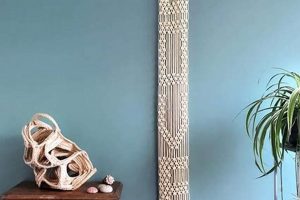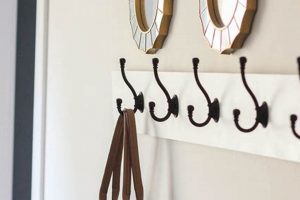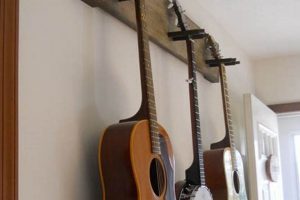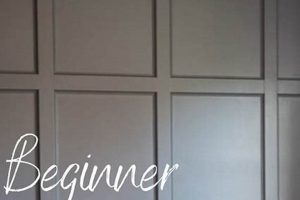A self-assembled wall-mounted light fixture offers a customizable approach to illuminating interior spaces. Such a project typically involves acquiring separate components a light source, a mounting bracket, wiring, and a shade or diffuser and assembling them according to a chosen design. An example might include repurposing a vintage metal container as a shade, attaching it to a wall-mounted electrical box, and wiring in a light socket.
This method provides significant cost savings compared to purchasing pre-made fixtures. It also allows individuals to create unique designs that reflect their personal aesthetic and complement existing dcor. Historically, crafting light sources was a necessity; this contemporary iteration allows for creative expression and resourcefulness, offering a tangible connection to that past while providing modern illumination.
The following discussion will explore the various materials suitable for constructing such a lighting element, delve into essential safety considerations regarding electrical wiring, and provide step-by-step instructions for creating a functional and aesthetically pleasing addition to a living space.
Essential Assembly Guidance
Achieving a successful outcome when self-assembling a wall-mounted light fixture requires meticulous planning and execution. The following guidance ensures both safety and aesthetic appeal.
Tip 1: Prioritize Safety: Before commencing any electrical work, disconnect the power supply at the breaker. Utilize a non-contact voltage tester to verify the circuit is de-energized. Neglecting this step poses significant safety risks.
Tip 2: Select Compliant Materials: Choose materials rated for electrical applications. Wiring should adhere to local electrical codes, and lamp holders must be compatible with the chosen light source (e.g., incandescent, LED). Improper material selection increases fire hazards.
Tip 3: Plan the Wiring Configuration: Determine the optimal wiring route within the wall to conceal connections. Utilize appropriate junction boxes to contain splices and protect them from damage. Exposed wiring presents a safety hazard and detracts from the aesthetic.
Tip 4: Ensure Secure Mounting: Employ appropriate mounting hardware suitable for the wall material (e.g., drywall anchors, concrete screws). The fixture’s weight must be adequately supported to prevent it from detaching and causing damage or injury.
Tip 5: Incorporate a Strain Relief: Implement a strain relief mechanism where the power cord enters the fixture housing. This prevents stress on the electrical connections if the cord is pulled or tugged. A properly installed strain relief enhances safety and extends the lifespan of the wiring.
Tip 6: Test Thoroughly: Upon completion, meticulously inspect all connections and wiring for accuracy. Once confirmed, restore power and verify the fixture functions correctly. Inconsistent operation indicates a potential wiring fault.
Adhering to these guidelines promotes a safe, functional, and visually appealing wall-mounted lighting installation, enabling cost-effective customization while minimizing potential hazards.
The subsequent sections will address specific design considerations and explore advanced techniques for enhancing the overall aesthetic impact of the completed project.
1. Illumination
Illumination, in the context of a self-assembled wall-mounted light fixture, represents the core functional element. It dictates the fixture’s purpose and the quality of light emitted, directly impacting the ambiance and usability of the surrounding space.
- Light Source Selection
The choice of light source fundamentally defines the illumination characteristics. Options range from traditional incandescent bulbs, known for their warm color rendering but lower energy efficiency, to compact fluorescent lamps (CFLs) and light-emitting diodes (LEDs). LEDs offer superior energy efficiency, longer lifespan, and versatility in color temperature and brightness, making them increasingly prevalent in modern designs. A poorly chosen light source can result in inadequate brightness, undesirable color casts, or excessive energy consumption.
- Brightness and Lumens
Brightness, measured in lumens, quantifies the total amount of visible light emitted by the source. The required lumen output is dependent on the intended application. A fixture intended for ambient lighting in a living room would necessitate a higher lumen output compared to one designed for accent lighting in a hallway. Insufficient lumens create a dim and functionally limited space, while excessive lumens can cause glare and discomfort.
- Color Temperature
Color temperature, measured in Kelvin (K), describes the perceived warmth or coolness of the light. Lower Kelvin values (e.g., 2700K) produce a warm, yellowish light, often preferred for creating a cozy and relaxing atmosphere. Higher Kelvin values (e.g., 5000K) produce a cooler, bluer light, suitable for task lighting or areas where alertness is desired. Selecting an inappropriate color temperature can clash with the intended dcor and negatively affect mood and productivity.
- Light Diffusion and Control
The design of the shade or diffuser significantly influences the direction and quality of the light. Translucent materials diffuse light, creating a softer, more even illumination. Opaque materials direct light, producing a focused beam suitable for highlighting specific areas. Poor light diffusion can result in harsh shadows and uneven illumination, while inadequate light control can cause glare and discomfort.
Therefore, a thoughtful approach to illumination, encompassing light source selection, brightness, color temperature, and diffusion, is crucial for crafting a wall-mounted light fixture that not only provides adequate lighting but also enhances the aesthetic appeal and functionality of the space it occupies. By carefully considering these factors, a self-assembled lighting fixture can be tailored to meet specific needs and preferences, resulting in a personalized and effective lighting solution.
2. Aesthetics
Aesthetics represent a crucial determinant in the conception and execution of a self-assembled wall-mounted light fixture. The visual appeal directly influences the fixture’s integration within a given space, transforming it from a mere functional object into a design element. A well-considered aesthetic enhances the room’s overall character, contributing to a cohesive and intentional atmosphere. Conversely, an aesthetic misalignment can detract from the existing dcor and create visual discord.
The impact of aesthetics is readily observable across various design styles. For example, a rustic-themed fixture might utilize reclaimed wood and exposed metal elements, thereby complementing a space characterized by natural materials and earth tones. In contrast, a minimalist design might employ sleek lines, polished surfaces, and concealed wiring, aligning with a modern, uncluttered interior. Real-world examples, such as repurposing vintage mason jars as shades for an industrial-style fixture, or employing geometric metal cutouts to create intricate light patterns in a contemporary setting, illustrate the diverse aesthetic possibilities. The practical significance lies in the ability to customize not only the functionality but also the visual impact, aligning the lighting fixture with the individual preferences and design intent.
Ultimately, a successful integration of aesthetics into a self-assembled wall-mounted light fixture requires a deliberate approach. This involves a comprehensive understanding of the existing space, a clear vision for the desired aesthetic, and a careful selection of materials and construction techniques that support that vision. While challenges may arise in achieving a specific aesthetic outcome, the effort yields a unique and personalized lighting solution that transcends mere utility, becoming an integral component of the room’s overall design. This reinforces the broader theme of customizable interior design, where individual expression and functional necessity converge.
3. Safety
The construction of a self-assembled wall-mounted light fixture inherently involves electrical work, presenting significant safety considerations. Neglecting these considerations can result in electrical shock, fire hazards, and potential property damage. The proper execution of wiring connections, insulation techniques, and grounding procedures directly impacts the overall safety and functionality of the lighting apparatus. For instance, incorrectly wired connections can lead to short circuits, overheating, and ultimately, electrical fires. Similarly, insufficient insulation exposes conductive elements, creating a shock hazard for individuals who come into contact with the fixture. These issues can arise from inexperience or negligence, necessitating a thorough understanding of electrical safety protocols.
Real-world examples underscore the importance of safety protocols. News reports frequently document residential fires originating from faulty wiring, often attributable to amateur electrical work. These incidents demonstrate the potential for significant financial loss and, more critically, physical harm. Furthermore, insurance companies may deny claims related to damages caused by improperly installed electrical systems, placing the financial burden squarely on the homeowner. Beyond fire hazards, improper grounding can create pathways for stray electrical currents, resulting in minor shocks or, in extreme cases, electrocution. The practical application of these insights reinforces the need for meticulous planning, careful execution, and adherence to all applicable electrical codes.
In summary, the creation of a wall-mounted light fixture demands a rigorous commitment to safety principles. Electrical expertise, either self-acquired through reputable resources or obtained through professional consultation, is paramount. Challenges associated with electrical work are best addressed through comprehensive planning, the use of appropriate tools and materials, and a steadfast adherence to established safety standards. This focus elevates a DIY project from a potentially hazardous undertaking to a safe and rewarding endeavor, ensuring the longevity and secure operation of the lighting fixture. The intersection of safety and DIY construction underscores the broader theme of responsible home improvement, emphasizing that aesthetic and functional goals must not compromise personal or property safety.
4. Materials
Material selection forms a cornerstone of the design and construction of any self-assembled wall-mounted light fixture. The choice of material dictates the fixture’s aesthetic, durability, and suitability for its intended environment. A deliberate approach to material selection is essential to ensure both visual appeal and functional longevity.
- Structural Components
The structural components, including the mounting bracket and supporting frame, require materials capable of withstanding the fixture’s weight and environmental conditions. Metal, such as steel or aluminum, provides robust support and resistance to corrosion. Wood, treated for moisture resistance, offers an alternative with a warmer aesthetic. The use of inappropriate materials can lead to structural failure, compromising safety and longevity.
- Light Diffusers and Shades
Materials used for light diffusion and shades significantly affect the quality of emitted light. Glass, both transparent and frosted, offers excellent light transmission and diffusion properties. Fabric shades provide a softer, more diffused light, while metal shades direct light in a more focused manner. The selection of material influences the light’s intensity, color, and direction, impacting the overall ambiance of the space.
- Electrical Components
Electrical components necessitate materials with specific conductive and insulating properties. Copper wiring, adhering to local electrical codes, provides safe and reliable electrical conductivity. Insulating materials, such as PVC or rubber, prevent electrical shorts and ensure user safety. Employing substandard or non-compliant electrical components poses significant fire and shock hazards.
- Fasteners and Adhesives
Fasteners and adhesives are critical for ensuring the structural integrity of the assembled fixture. Screws, bolts, and rivets provide mechanical connections, while adhesives bond components together. The choice of fastener depends on the materials being joined and the load they must bear. Incompatible fasteners or adhesives can result in weakened connections and potential structural failure.
The interconnectedness of these material choices highlights the importance of a holistic design approach. The structural components must support the weight of the shade, while the electrical components must be compatible with the chosen light source. A well-designed and executed wall-mounted light fixture reflects a careful consideration of these material properties, resulting in a durable, aesthetically pleasing, and safe lighting solution.
5. Structure
The structural integrity of a self-assembled wall-mounted light fixture is paramount to its functionality, safety, and longevity. A robust structure ensures the fixture can withstand its own weight, resist environmental factors, and maintain its intended form over time. Inadequate structural design can lead to premature failure, posing potential safety hazards and diminishing the fixture’s aesthetic appeal.
- Mounting Mechanism
The mounting mechanism serves as the critical interface between the light fixture and the wall. Its design must account for the fixture’s weight, potential vibrations, and the composition of the wall itself. A poorly designed mounting mechanism, utilizing inadequate hardware or inappropriate materials, can result in the fixture detaching from the wall, causing damage or injury. Examples include using drywall anchors in solid concrete or failing to properly secure the fixture to a wall stud.
- Supporting Frame
The supporting frame provides the skeletal framework for the light fixture, bearing the weight of the shade, light source, and any decorative elements. The frame’s material and construction must be chosen to ensure adequate strength and rigidity. A weak or poorly constructed frame can deform under load, causing the shade to sag or the entire fixture to collapse. Examples include using thin-gauge metal that bends easily or failing to properly join frame components, creating weak points.
- Wiring Enclosure
The wiring enclosure protects the electrical wiring and connections from physical damage and environmental factors. A robust enclosure prevents accidental contact with live wires, mitigating the risk of electrical shock. A poorly designed enclosure may expose wiring to moisture or impact, leading to short circuits and potential fire hazards. Examples include using a flimsy plastic enclosure that cracks easily or failing to properly seal the enclosure against moisture ingress.
- Heat Dissipation
For fixtures utilizing heat-generating light sources (e.g., incandescent or halogen bulbs), the structure must facilitate adequate heat dissipation. Insufficient heat dissipation can lead to overheating, damaging the light source, surrounding materials, and potentially creating a fire hazard. Proper ventilation and the use of heat-resistant materials are crucial. An example of poor heat dissipation would be a fully enclosed fixture with no ventilation using a high wattage incandescent bulb, leading to a build-up of heat and potential damage.
The structural design of a self-assembled wall-mounted light fixture is not merely an aesthetic consideration; it is a fundamental aspect of its functionality and safety. A well-engineered structure provides the foundation for a durable, reliable, and visually appealing lighting solution. Careful attention to the mounting mechanism, supporting frame, wiring enclosure, and heat dissipation ensures the fixture will perform its intended function safely and effectively for years to come.
6. Installation
Installation represents the culminating phase in the creation of a self-assembled wall-mounted light fixture. It directly determines the fixture’s functional integration within a space and profoundly impacts its safety and long-term performance. Improper installation negates the benefits of careful design and material selection, potentially rendering the fixture unusable or, worse, hazardous. The success of the entire endeavor hinges upon a meticulous and informed installation process.
The process typically involves several key steps, each with significant implications. First, safe disconnection of electrical power is paramount to prevent electrical shock. Second, proper mounting of the fixture to the wall, utilizing appropriate hardware suitable for the wall’s composition (e.g., drywall, plaster, concrete), ensures stability and prevents detachment. Third, correct wiring of the fixture to the existing electrical system, adhering to local electrical codes, is crucial for safe and reliable operation. Examples of deficient installation range from loosely secured mounting brackets leading to fixture instability to incorrectly wired connections causing short circuits and potential fire hazards. The practical significance lies in understanding that even the most aesthetically pleasing and well-constructed fixture is rendered useless, or even dangerous, without a proper installation.
In summary, installation is not merely a final step but an integral component of the overall self-assembly process. It bridges the gap between a collection of parts and a functional, safe, and aesthetically integrated lighting element within a space. Challenges during installation, often stemming from unforeseen structural issues or complex wiring configurations, necessitate careful planning and, when appropriate, consultation with qualified professionals. The understanding of installation’s critical role reinforces the broader theme of responsible and informed DIY projects, emphasizing the need for both creativity and a commitment to safety and code compliance.
Frequently Asked Questions
The following addresses common inquiries regarding the construction of self-assembled wall-mounted light fixtures. This information is intended to provide clarity and promote safe and effective construction practices.
Question 1: Are specialized tools required for the construction of a wall-mounted light fixture?
A basic toolkit typically suffices. Essential tools include wire strippers, screwdrivers (various types), pliers, a voltage tester, and a drill. Depending on the complexity of the design and the materials used, additional tools such as a soldering iron, metal cutter, or wood saw may be necessary. Acquisition of appropriate tools is essential for ensuring a safe and precise assembly process.
Question 2: What electrical codes must be observed during wiring?
Adherence to local electrical codes is mandatory. These codes dictate wire gauge, insulation types, grounding procedures, and junction box requirements. Failure to comply with these regulations can result in electrical hazards, fire risks, and potential legal liabilities. Consulting with a qualified electrician is recommended if uncertainty exists regarding code requirements.
Question 3: What are the primary safety precautions during electrical wiring?
The most crucial safety precaution is to disconnect power at the circuit breaker before commencing any wiring work. Verification of the circuit’s de-energized state with a voltage tester is imperative. Employing proper grounding techniques and insulating all exposed wires is also essential. Neglecting these precautions poses a significant risk of electrical shock.
Question 4: What materials are best suited for constructing the fixture’s shade or diffuser?
The selection of shade materials depends on the desired aesthetic and light diffusion characteristics. Glass offers excellent light transmission and is available in various textures. Fabric provides a softer, more diffused light. Metal can be used to direct light and create specific visual effects. Selection must also consider heat resistance, particularly if using incandescent bulbs.
Question 5: How can one ensure the fixture is securely mounted to the wall?
The mounting method depends on the wall’s composition (drywall, plaster, concrete). Utilizing appropriate anchors designed for the wall type is critical. For drywall, heavy-duty anchors or toggle bolts are recommended. For concrete, masonry screws are necessary. In all cases, ensuring the mounting hardware can support the fixture’s weight is paramount.
Question 6: What steps are involved in testing the completed fixture?
Before energizing the circuit, a thorough visual inspection of all wiring connections is essential. Verify that all wires are properly connected and insulated. Once confirmed, restore power and observe the fixture’s operation. Any flickering, sparking, or unusual behavior indicates a potential wiring fault that requires immediate attention.
Adhering to these guidelines will enhance the likelihood of a safe and successful outcome when constructing a self-assembled wall-mounted light fixture. Prioritizing safety and code compliance is crucial throughout the entire process.
The subsequent section will explore advanced design considerations for enhancing the overall impact of self-assembled lighting.
DIY Wall Sconce
The foregoing examination of the DIY wall sconce has traversed the domains of design, safety, and functionality. Initial considerations encompass aesthetic preferences, progressing to meticulous planning involving material selection, structural integrity, and adherence to electrical codes. The analysis emphasizes the imperative of safety protocols throughout the construction and installation phases, highlighting the potential consequences of negligence. Furthermore, it underscores the importance of responsible material sourcing and appropriate tool usage, thereby minimizing potential hazards and maximizing the lifespan of the finished product.
The creation of a custom lighting element represents a synthesis of practical skill and aesthetic vision. While the initial investment of time and effort may exceed that of purchasing a pre-fabricated fixture, the resultant personalized outcome offers unparalleled value. Continued diligence in adhering to safety standards and staying abreast of evolving electrical codes will ensure the enduring functionality and aesthetic appeal of the DIY wall sconce, enriching the illuminated environment for years to come.







